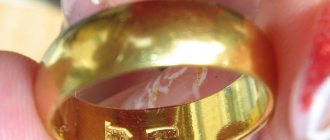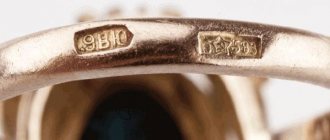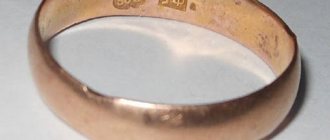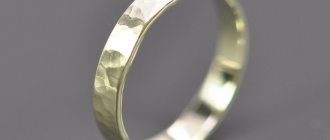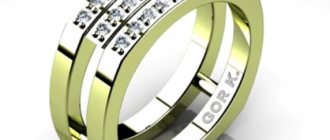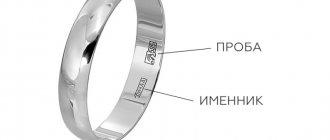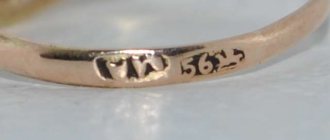Gold hallmarking is a procedure for placing a special mark on jewelry and other items made of precious metal. But what is this for?
Sample and mark are mandatory attributes of each precious metal product, which confirm their compliance with the state standard and the percentage of “pure” precious metal content.
Most precious metals, especially gold, are very soft in texture. To prevent deformation of products, give the alloy a certain color, as well as the necessary casting, malleable and plastic properties, special impurities are added - alloys of precious and base metals or, in other words, alloys. A special designation - a sample on the product - helps determine the amount of additives and impurities and “pure” precious metal. For example, if a piece of jewelry is marked 585, this means that per 1000 grams of the alloy from which the product is made, there are 585 grams of gold and 415 grams of impurities of other metals.
The state hallmark is considered a quality guarantee sign, indicating that the product has passed a special test by the state inspection and officially has a hallmark not lower than that indicated in the hallmark.
Has such a system of samples and stamps always existed? When did the first special designations for products made of precious metals appear - marking the hallmark of gold and silver? Read on and you will find the answers to these questions.
What kind of sample is this
On jewelry made before 1927, 56 was the most common. Usually, thanks to the mark on these jewelry, you can find out who made the product. Jewels with raised markings are of particular importance, since only after 1897 marks began to be made depressed, similar to modern ones. Compared to today's standards, 56 corresponds to 585 gold.
Briefly about the history of appearance
Mandatory marking on products made of precious metals was introduced by Peter I. The spool system was adopted to systematize the quality of gold, control accounting and at the same time bring order to the jewelry industry. Until 1733, products were made without sample. The proposed classification was used until 1927.
History of 56 samples
The old gold alloy, which was marked with the number 56, spread throughout Tsarist Russia. There is significant evidence of this - jewelry items that have come to us from the depths of the 18th and 19th centuries. The stamp, which was placed on almost any piece of jewelry of that period, including coins, indicated not only the number of the gold alloy, but also the surname and initials of the master who made it, the coat of arms of the city, etc. The size of the stamp depended solely on the size of the product. Until the end of the 19th century, this sign had a convex shape. Only in 1897 did the mark take on its usual depressed appearance.
The replacement of the spool system with the metric system, which is still in effect today, took place in 1927. All products that had not found their owners at that time received a new stamp indicating 583, and then 585.
Composition and properties
To make this sample, 56 parts of pure gold and 40 parts of alloys were used. In terms of properties, quality and composition, it corresponds 100% to modern 585 standard. The following metals were often used as alloys:
- silver;
- copper;
- nickel;
- zinc;
- brass;
- palladium.
Such alloys changed the color of the alloy, its ductility and wear resistance. Palladium increased the price of the product several times due to its cost.
Strength
Products made from 56 standard have fairly high strength. The strongest jewelry is considered to be made from an alloy containing nickel, brass or zinc. In addition, this ligature made it possible to create various woven patterns on the decoration.
Alloy shade chart
| Color | Share of gold | Silver | Copper | Nickel |
| Pink (red) | 58.5% | 9% | 32.55% | — |
| Yellow | 58.5% | 18.75% | 22.75% | — |
| Pale yellow | 58.5% | 28% | 13.5 | -? |
| Yellow-green pale | 58.5% | 38.25% | 3.25% | -? |
| White | 58.5% | 25.5% | — | 16.5% |
Expert opinion
Vsevolod Kozlovsky
6 years in jewelry making. Knows everything about samples and can identify a fake in 12 seconds
Palladium changed the properties of products; it did not have a significant effect on color.
Brand
Until 1897, items made from 56 samples were marked with a raised mark. In the 20th century, only depressed ones were done. You can see what it looks like in the photo.
How many carats are in this sample?
The spool system was used in Tsarist Russia, while the metric system was used in the Soviet Union. In the West, the carat system is used to measure fineness.
| Spool value | Metric value | Carat value |
| 56 | 585 | 14 |
Alloy Application
Gold of this type was used to make jewelry and various types of jewelry. Most often, the 56 sample can be found on rings and rings, but it was also used to create earrings, chains, bracelets, crosses, pendants and other products. Today it is used more often than others for making wedding rings.
In the Soviet Union, such a test was used in almost all gold products, marking them with the 585 stamp.
Interestingly, until 1914, this gold alloy was used, among other things, to make Olympic medals and sports cups.
Advantages and disadvantages
Precious metals, both past and present, have been good investments. Of course, if the jewelry doesn’t look the best or belongs to items that were common at that time (earrings without precious stones, a chain, a cross), then they will buy it back not too expensively, perhaps only for the price of scrap jewelry.
The decoration of such a sample is assessed quite highly, taking into account its historical value , because very often jewelry of those centuries was supplemented with precious stones or they were created by famous master jewelers, for example, Pavel Ovchinnikov or the Grachev brothers. Jewelry made from 56-karat gold was distinguished by its increased strength , which is why many beautiful unique products of high artistic value made from this alloy have been preserved.
The main advantages of 56-carat gold are the following characteristics.
- Wear resistance. Differences in the percentage of impurities affect the amount of wear of products, and since gold itself is a soft metal, this alloy marking is more resistant to mechanical stress.
- Alloy hardness. This characteristic also depends on the quality of the alloy.
- Extended service life.
- Due to the difference in the ratios of additional elements in the alloy, differences appear in the color scheme of the alloy . The most beautiful shades of green, yellow, pink and red can be found in the products of that time.
- Plastic. This parameter allowed jewelers to create truly priceless masterpieces of jewelry, which today are museum exhibits.
The disadvantages include possible allergic reactions due to the high nickel content in the alloy, as well as the difficulty of repair if the jewelry is damaged.
Many workshops refuse to repair 56-karat jewelry due to differences in alloys.
Advantages and disadvantages
56 (585) is considered a more valuable alloy than 583, which is most popular in jewelry stores today. But in terms of gold content, 56 is inferior to most samples on the precious metals market. Despite this drawback, it remains popular with us due to certain advantages:
- hardness and wear resistance;
- wide range of colors;
- increased strength and durability;
- plasticity, which allows you to create unique jewelry.
The alloy acquires these properties due to the content of various impurities in it: zinc, copper, palladium, silver, nickel, platinum. The amount of additives does not spoil the overall quality of gold, but only allows you to control its properties.
High-grade and low-grade gold
Highest quality gold
Gold can be high-grade and low-grade. High-grade gold is most often used in bank bars and coins (antique, collectible, investment). Despite the fact that such gold is the most expensive, jewelry made from it is rare. Fine gold is too soft for widespread use. High-grade gold is used as an investment to preserve savings from depreciation. The highest standard of gold corresponds to the digital designations: 999, 24 carats, 96 spools.
Lowest grade of gold
Low-grade gold has high strength and a significantly lower price. Products with high wear resistance are most often made from it, and much less often - jewelry. Despite its strength and durability, jewelry made from low-grade precious metal does not look as attractive as jewelry made from gold of popular standards. The lowest standard of gold corresponds to digital designations: 333 or 8 carats.
Where can I buy and sell such a sample?
Original 56 mark jewelry can only be purchased from antique dealers. But its metric analogue is available in almost any jewelry store. It was used more often in the Soviet Union, but even today this alloy is found quite often in various products. Jewelry marked 56 hallmark can only be purchased in antique stores, from private individuals or in pawn shops.
Pawnshop and antique dealer
The cost of products with the mark 56 is very high, as they have historical value. The most inexpensive will be wedding rings from pawn shops, inherited ones. But it is difficult to find such specimens.
The minimum price per gram of this alloy in antique shops and pawn shops is 2,000 rubles.
The price increases several times if the product contains precious stones, and the cost will be even higher if there is a jeweler’s mark. Some 56-carat jewelry has a seven-figure price tag.
Which sample should I choose?
Looking at the treasures in the windows of jewelry stores, millions of buyers ask themselves the question - which sample to choose? Which is better?
If you do not have color preferences, then you need to choose a product according to three main criteria:
- practicality
- aesthetic appeal
- price
The most common gold standard is 583rd . The color of such a metal can vary - this directly depends on the percentage of various metals in the alloy. For example, if an alloy of 583-carat gold consists of 58.3% gold, 36% silver, 5.7% copper, then in this case the metal has a greenish tint. The same 583rd sample with a content of 18.3% silver, 23.4% copper, already has a pink tint. If this alloy contains 8.3% silver and 33.4% copper, then the gold will have distinct shades of red.
In general, 583- carat gold is considered the most practical, and therefore enjoys increased popularity. The 50% percentage of gold in the alloy makes the products durable - such jewelry is less scratched and does not deform.
The same cannot be said about 958-carat . This alloy is not durable, so it is not in high demand among jewelry buyers. This alloy also contains small amounts of silver and copper. The metal turns out to be bright yellow – almost pure gold. Often used in making wedding rings. But due to the increased softness, the surface of such jewelry requires regular polishing.
The alloy of 750 standard consists of 3 components - gold, copper, silver. Sometimes some rhodium, palladium, nickel and zinc are included as alloys. The color of the metal can be very diverse - from yellow-green to reddish and white. The alloy is very technical and ideal as a base for jewelry enamel. Almost always, jewelry made of 750-carat gold is distinguished by its noble shades and original, sophisticated design, since it is not produced in very large quantities.
The 375-carat gold alloy consists of the following components: 37.5% gold, 10.0% silver, 48.7% copper, 3.8% palladium. Widely used in the production of wedding rings.
How much does 1 gram of gold of this standard cost?
The price of gold is determined by the Central Bank of the Russian Federation. But the market value has different meanings for scrap and jewelry. Jewelry often has historical value, so its evaluation should be carried out by a specialist. In this case, the price is influenced by the presence of precious stones, the mark of the jeweler, who used the jewelry and other factors.
| Price 999 standard according to the Central Bank | Market value of the sample today | Scrap price | Price in jewelry |
The role of Turkish gold
In the 80s and 90s, the 585 sample began to cause indignation among the Soviet people. This was due to the massive import of jewelry of this standard from Turkey, which was made using gold foil. These products fell apart and deteriorated from any unconventional influence on them, and also faded, changing their color, and were not durable, easily bent and deformed.
The same goes for precious stones. Their crafts were widely used for gold inserts. They were also not resistant to environmental irritants, and already in the first months they deteriorated and changed their color. Numerous complaints about the poor quality of the product provoked a ban, which was introduced in 2000.
After some time, gold from domestic producers returned to the shelves. It was of much better quality and did not cause any indignation on the part of buyers.
Recommendations for care and cleaning
Products made from precious metals can change color, become dirty and lose their shine. To combat this, you need to clean your jewelry regularly. For this purpose, various means are used. Housewives often use soap solutions, ammonia, and hydrogen peroxide when wiping jewelry. But it is best to purchase a special jewelry paste.
Expert opinion
Vsevolod Kozlovsky
6 years in jewelry making. Knows everything about samples and can identify a fake in 12 seconds
Stores sell entire kits for caring for gold items.
Does gold darken
Darkening on gold products indicates the presence of foreign impurities and low quality of the alloy. 56 standard does not darken, as the quality of this type of gold is high. Slight darkening may occur on items from the 18th–19th centuries.
Why do gold items turn your fingers black?
If the skin of your fingers turns black when wearing a gold ring, this indicates excessive sweating. As a result of the reaction of metal and human sweat, blackening appears. According to experts, it is possible that your menu contains too much meat products. Popular superstitions claim that blackening is a sign of a serious illness or damage to a person.
Appearance of gold streaks
Streaks can appear when a person wearing gold jewelry comes into contact with smoke or soot. Sometimes the cause is excessive sweating. To combat blackening and the appearance of streaks, use high-quality hand cosmetics, wear gloves when working and regularly check your health.
Carat sample system
Based on the British carat system, one carat (K) is equal to twenty-fourths of the alloy. A similar sampling system is common in Switzerland, the United States of America, Canada and Western European countries. In Ireland, two standard systems are used equally: carat and metric. The noble metal of twenty-four carats (24K) is considered the purest. It is completely free of any other impurities. Next comes 14-karat gold, which contains fourteen parts of the precious metal and ten parts of other metals.
Tips for choosing gold jewelry
Purchasing a gold item is a serious procedure. You need to analyze prices and quality in different jewelry stores, checking first of all the following:
- grinding quality;
- uniformity of the surface of the product;
- absence of defects: cracks, depressions, abrasions, dents, breaks, scratches;
- quality of decoration.
In addition, you should pay attention to the tag - a kind of passport of the jewelry. It must be formatted correctly and contain the following information: manufacturer, name;
- company address or contact details;
- the name of the product itself;
- type of metal and its purity;
- weight;
- price.
Expert opinion
Lyudmila Pestereva
Our most experienced gold investor
Ask a Question
Tags that do not have this information are not considered a passport of the product and indicate poor quality of the jewelry, possible counterfeiting and cheapness.
Silver
In Russia, the following silver standards are legally permitted for use: 800, 830, 875, 925, 960, 999.
875 standard silver is the most practical and widespread. It is from this alloy that most silver jewelry is made. The alloy contains 81.5% pure silver. The rest is made up of copper, which effectively prevents the oxidation of the metal. 875 sterling silver is less susceptible to tarnishing than 830 and 720 sterling silver.
Tableware items are made from 916 sterling silver. The 960-grade alloy is used in the manufacture of particularly filigree products.
To protect silver and brass items from oxidation, their surface is often coated with a thin layer of .999 gold (gilding) or .999 silver (silver plating).
Reviews
Maria:
“My grandmother gave me a ring, no stone, just a nice ring with a small pattern. On the inside there is an o, which, as I later learned, means a test. At first I doubted that we have a three-digit standard system for gold. I googled it and it turned out to be simple: the ring was made back in the days of the spool system. What can I say - the ring is beautiful, it has not changed color, does not darken and does not stain the skin. Grandma clearly looked after him, I continue this tradition.”
Konstantin:
“A chain with 56 hallmarks, the lock broke, I turned to the jeweler for help. He suggested installing a new one, made from a modern alloy. There was no choice - I had to replace it. And a year later I got caught on the railing and pulled the chain hard, so the new lock broke, but my father’s 56-grade chain was not damaged anywhere.”
Arina:
“Good gold was made in Tsarist Russia, my father has a ring that has been inherited for several generations, the 56th standard is marked with a hallmark. It does not turn black, does not stain the skin, and does not need to be cleaned often - it’s a pity that there are no such good alloys today.”
